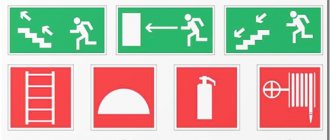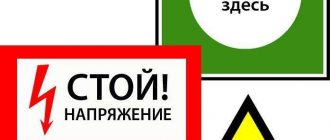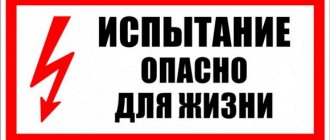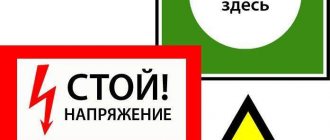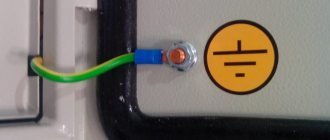Modern life cannot be imagined without electricity. In everyday life, in production, in transport - electric current flows everywhere. When working with any electrical appliances, you must follow certain rules. Any violation can lead to irreparable consequences. Workers servicing electrical installations should be especially careful about this issue. This is a complex of machines and devices, lines along with auxiliary equipment and the premises in which they are located. The main purpose of the above systems is the production, transformation, and transmission of electrical energy.
To ensure that nothing threatens human life and health in places with increased risk, there are special electrical safety signs. They are installed to prevent or restrict movement and actions in a given area. In this way, a safe zone is determined. This preventative measure prevents the occurrence of electric shock victims.
electrical safety
Difference between signs and posters
Fire safety signs and plates: meaning, how and where to place them
At any enterprise there are certain restrictions, one way or another related to electricity. Labor safety regulations require the installation of electrical safety signs in places where there is a danger of electric shock. In their absence, the head of the organization is responsible for industrial accidents.
For your information! Sign Safety signs or posters are used as additional means of protection. Some are installed permanently, but sometimes it becomes necessary to move electrical safety warning signs to carry out, for example, repairs or routine inspections.
Signs are always permanent. In contrast, posters are either portable or permanent.
For example, during preventive and hazardous work, an accident occurred in which people were injured due to a lack of information about the danger. In such cases, legal entities and officials are held liable. Depending on the severity of the incident, it can be administrative or criminal.
Overview of Electrical Safety Warning Signs
When it is dangerous to approach nearby live parts, the following signs are posted (in the form of stationary posters and plates, or painted on the body of the electrical installation):
- “Stop! Voltage!" A portable sign warning that it is dangerous to approach an electrical installation. The inscription in black letters on a white background.
- “He will kill! Don't get in!" It is prohibited to climb inside the room or shield.
- “A test is being carried out! Don't come closer! They are hung directly during work involving high voltage.
- "Electric field. High danger. Passage without protective equipment is prohibited! Prohibition on movement near high-voltage installations to avoid remote electric shock.
- “The electrical installation is live! Be careful." The sign is posted on electrical equipment and installations of various classes to prevent electric shock. It can also be applied with paint to the surface of concrete.
Types of email signs safety according to GOST
Safety signs on labor protection at work
There is a division of safety signs into the following groups:
- prohibiting;
- warning;
- prescriptive;
- index.
This classification is established by GOST 12.4.026-2015.
Prohibitions imply a complete restriction on any actions that could cause harm to workers located in the area of electrical installations and carrying out any actions there. They also prohibit working or carrying out any manipulations without protective equipment inside certain premises and installations.
Prohibiting
Warnings serve to indicate possible dangers not only to human health, but also to life, as well as harmful production factors. They perform the following task: to increase attention or warn workers and third parties about an object that is potentially dangerous. Failure to comply with special safety measures can lead to irreparable consequences, severe injuries, injuries, or even death.
For your information! The "Dangerous Voltage" sign is a typical example of a warning sign. It is permanent. An example of a portable poster: “Tests are life-threatening!”
Maintenance personnel should notice the warning sign from afar. Sometimes, for clarification, they are supplemented with electrical safety warning signs in the form of a rectangle.
Warning
In electrical safety signs, according to GOST, lightning indicates the presence of voltage in the network. An example of a prohibitory poster: “DO NOT TURN ON! People are working." The prohibitory poster has the shape of a rectangle and is suspended on handles and levers that supply voltage.
Prescriptive ones are needed to identify safe places in which repairs or maintenance of electrical equipment can be carried out. Their purpose is also to indicate safe passage to the area where manipulations are carried out. Example of a portable instructional poster: “Work here.”
Prescriptive
The purpose of the signs is to show the location of electrical equipment and devices that require strict adherence to safety regulations.
Pointing
Important! Sometimes it is allowed to use two signs at once: a prohibition sign and an instruction sign. Then the second one is always located higher than the first one.
The table clearly shows the distribution of signs by groups:
| View | Color | Form | Meaning |
| Prohibiting | Red | Circle crossed out by a stripe | Prohibition of hazardous activities from an electrical safety point of view |
| Prescriptive | Blue | Circle | Tips and tricks to avoid dangerous activities |
| Warning | Black symbol on a yellow background | Triangle | You need to be careful and careful, there may be a danger of electric shock |
| Fire safety | Red | Rectangular or square | Indicates the placement of fire fighting equipment |
| Pointing | Blue | Information or instructions | |
| Evacuation | Green | Passages and evacuation areas |
Where to get and where to install
It may seem that it is not difficult for an employer to make such symbols on their own. But taking into account the extensive list of GOST requirements for design and production, strict guidelines regarding the materials used, it is advisable to place an order for the production of this specific product in an organization specializing in the named area of activity.
The main requirement for placement is visibility for the people to whom they are addressed. Signs must be placed so that they do not distract attention, do not interfere with the employee’s performance of his task, do not block aisles, driveways, or interfere with the movement of cargo. Thus, the management of the institution selects placements based on established criteria.
Accommodation options are:
| Image | Name | Where to place |
| Prohibiting | ||
| No smoking | In rooms and areas (doors, walls) where flammable substances are contained and where smoking is prohibited. | |
| No entry | Near the entrance to danger zones. | |
| Entry (passage) with animals is prohibited | On the gates and doors of those objects where animals are not allowed, or where they cannot be. | |
| It is prohibited to use a mobile phone | At objects (doors, entrances) where communication means cannot be used. | |
| Obstructing aisles and/or storing is prohibited | On evacuation routes, at exits, where fire-fighting equipment is located, and other places. | |
| Warning | ||
| Fire hazardous | On entrance doors, containers. | |
| Dangerous! Toxic substances | In places where such substances are stored, produced and used. | |
| Carefully! Radioactive danger | In places where substances hazardous to employees are stored, produced and used. | |
| Carefully! Slippery | In places where there are slippery areas. | |
| Prescriptive | ||
| Work with safety glasses | For work where you need to protect your eyesight. | |
| Work in a safety helmet (helmet) | For work where you need to protect your head. | |
| Wear protective gloves | For work where you need to protect your hands from the dangerous effects of harmful substances or electric current. | |
| Passage here | In those areas where you can pass. | |
| Work in protective clothing | When working in areas where the employee needs to use PPE. | |
| Fire safety signs | ||
| Fire hydrant | At the location. | |
| Fire escape | At the location. | |
| Fire extinguisher | At the location. | |
| Button for turning on fire automatics installations (systems) | In places where fire alarms are manually activated. | |
| Evacuation and medical and sanitary purposes | ||
| The exit is here | Above the doors (or on the doors) of escape routes. On the wall of the facility along with a directional arrow that will tell you where to move to evacuate. | |
| Directional arrow | Used only in conjunction with others to show the direction of movement. | |
| Exit sign | Above the corresponding doors. | |
| First aid kit | Placed on walls and doors of rooms to indicate where the first aid kit is stored. | |
| Index fingers | ||
| Meal point (place) | On the doors of those rooms where food can be eaten. | |
| Drinking water | On the doors of those rooms where drinking water taps are located. | |
| Smoking area | Where smoking is allowed in public facilities. | |
Manufacturing requirements
Technical measures when working in electrical installations
The production of milestone signs is clearly regulated by GOST 12.4.026-2001.
- Warning signs should have a triangular shape with a yellow signal color. The same GOST defines the basis for prohibitory signs. The main signal color here is red. The prescribed predetermined shape is a round shape with a blue signal color.
- Dielectric materials are used to make signs. GOST recommends the use of non-flammable PVC plastic with a thickness of 2 to 4 mm with a photoluminescent or reflective base. Metal may only be used for signs remote from electrical installations.
- It is allowed to print safety signs and explanatory notes on film with a self-adhesive backing.
- It is allowed to mark and place stationary electrical safety signs with paint using stencils. At night, all electrical safety information should be backlit.
- If safety signs are voluminous, then the quality of the design must be durable, the sign must be securely attached. Installation and dismantling for maintenance and repair should be as simple as possible.
- Safety signs in electrical installations that are intended to be placed outside buildings must be resistant to various atmospheric influences: rain, snow, frost, dust, fog and sunlight.
For your information! Sign All sizes of signs are calculated from the point of view of readability and are given in GOST 12.4.026-2001.
Responsibility for absence
The head of any organization is obliged to establish a system for protecting the work of employees and create conditions for their safe activities. One of the elements of such a system is the presence of markings in danger zones. If signs are missing or placed in violation of the requirements, management may be held accountable in the form of a fine and an order to eliminate the identified violations. The employer must close the danger zones, conduct training sessions with employees, and record the information in a special journal.
What awaits an employer who violates established standards? The absence of signs or their non-compliance with the requirements established by GOST entails liability under Article 5.27.1 of the Code of Administrative Offenses of the Russian Federation in the form of a warning or a fine:
- for an official - 2000–5000 rubles;
- for individual entrepreneurs - 2000–5000 rubles;
- for a legal entity - 50,000–80,000 rubles.
Repeated violation will aggravate the situation and entail:
- for an official - a fine from 30,000 to 40,000 rubles or disqualification from 1 to 3 years;
- for individual entrepreneurs - a fine of 30,000 to 40,000 rubles or suspension of activities for up to 3 months;
- for a legal entity - a fine of 100,000 to 200,000 rubles or suspension of activities for up to 3 months.
An equally strict approach to the presence of fire signs. Article 20.4 of the Code of Administrative Offenses of the Russian Federation establishes fines from 20,000 rubles (for individual entrepreneurs) to 200,000 rubles (for organizations).
Thus, signs regarding the safe work of employees must be present not only in places with a high degree of risk - construction sites, industrial facilities, but also in those premises where events, for example, of a public nature, are held. These symbols must be made in strict accordance with the requirements of GOST. If the latter are not observed, the responsible person will face punishment.
Product classification
Posters and signs warn of the dangers associated with approaching energized equipment. Safety posters may also identify the workplace.
Based on the nature of their application, electrical safety posters are divided into portable and stationary (permanent).
Classifications of posters and signs:
Prohibiting
Designed to prohibit switching with devices (turning on or off), they are needed so that no one mistakenly applies voltage to electrical equipment. The inscriptions are made in red letters on a white background and with a red frame, or vice versa in white letters on a red background.
Dimensions of rectangular posters (width x height): 200x100 or 100x50 mm.
Prohibition posters
Warning
Designed to warn of approaching live parts or parts at a life-threatening distance. Signs are used in electrical installations up to 1000 V and above.
The inscriptions are made in red letters on a white background and with a red frame, or a yellow triangle with a black frame and a zipper, or black paint, which is applied to reinforced concrete supports, fences or slabs.
Dimensions of rectangular signs: 300x150. The dimensions of the sides of the triangle are usually 300x300x300, but if the sign is used indoors or pasted on equipment, then its side dimensions can be: 25, 40, 50, 80, 100, 150 mm.
Prescriptive
They are used to indicate places of work and for a safe approach to the workplace. The inscriptions and frames are made in blue and white letters.
Sizes of square signs: 100x100 or 250x250 mm, 200x200 and 80x80 mm.
Mandatory signs
Pointing
Indicates that a certain area of the electrical installation is grounded and that voltage must not be supplied to electrical equipment, as well as to indicate the location of various objects and devices. There is only one sign indicating “GROUNDED” in blue on a blue background. Poster dimensions: 200x100 or 100x50 mm The width of the white border should be 5-13mm.
Pointing sign
By nature of application
This classification for electrical safety posters and signs allows you to determine whether the device will be installed on a permanent basis or whether it is portable. The first, for the most part, include signs, for example, voltage indicators, which are a triangular information plate with a stylized image of lightning.
Stationary
Of the types listed above, these include the signs given in paragraphs 5 and 6, as well as the warning poster from paragraph 10
Portable
All other posters that were discussed are portable, that is, those that are installed in new places.
It makes sense to create sets of portable posters only when standard maintenance or repair of electrical network components or equipment powered by it is performed. In such cases, you can take a certain number of mandatory, prohibitive or other safety posters and signs, including “danger to life” signs, in advance.
